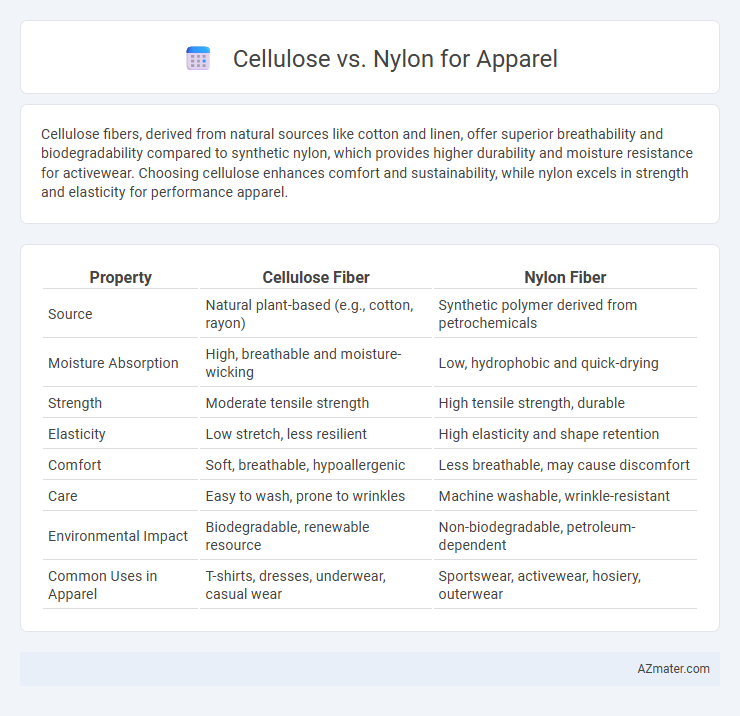Cellulose fibers, derived from natural sources like cotton and linen, offer superior breathability and biodegradability compared to synthetic nylon, which provides higher durability and moisture resistance for activewear. Choosing cellulose enhances comfort and sustainability, while nylon excels in strength and elasticity for performance apparel.
Table of Comparison
| Property | Cellulose Fiber | Nylon Fiber |
|---|---|---|
| Source | Natural plant-based (e.g., cotton, rayon) | Synthetic polymer derived from petrochemicals |
| Moisture Absorption | High, breathable and moisture-wicking | Low, hydrophobic and quick-drying |
| Strength | Moderate tensile strength | High tensile strength, durable |
| Elasticity | Low stretch, less resilient | High elasticity and shape retention |
| Comfort | Soft, breathable, hypoallergenic | Less breathable, may cause discomfort |
| Care | Easy to wash, prone to wrinkles | Machine washable, wrinkle-resistant |
| Environmental Impact | Biodegradable, renewable resource | Non-biodegradable, petroleum-dependent |
| Common Uses in Apparel | T-shirts, dresses, underwear, casual wear | Sportswear, activewear, hosiery, outerwear |
Introduction to Cellulose and Nylon in Apparel
Cellulose fibers, derived from natural sources such as cotton, linen, and rayon, offer breathable, biodegradable, and moisture-absorbing properties ideal for apparel. Nylon, a synthetic polymer made from petrochemicals, provides exceptional strength, elasticity, and durability, making it popular for activewear and outerwear. The choice between cellulose and nylon in apparel depends on factors like comfort, environmental impact, and performance requirements.
Origin and Composition of Cellulose Fibers
Cellulose fibers, derived from natural sources such as cotton, flax, and wood pulp, are composed primarily of long chains of glucose molecules forming a plant-based polymer. These fibers exhibit high breathability and moisture absorption due to their hydrophilic nature, making them ideal for comfortable apparel. In contrast, nylon is a synthetic polymer made from petrochemical precursors, emphasizing the renewable and biodegradable advantages of cellulose fibers in sustainable fashion.
Overview of Nylon: Synthetic Fiber Properties
Nylon is a synthetic fiber known for its exceptional strength, elasticity, and resistance to abrasion, making it a durable choice for apparel. It offers moisture-wicking properties and quick-drying capabilities, enhancing comfort during physical activities. Its resilience against chemicals and mildew ensures long-lasting performance in various environmental conditions.
Environmental Impact: Cellulose vs. Nylon
Cellulose-based fibers, such as cotton and lyocell, are biodegradable and derived from renewable plant sources, resulting in a lower carbon footprint compared to nylon, which is a synthetic polymer derived from petrochemicals. Nylon production consumes significant amounts of energy and releases nitrous oxide, a potent greenhouse gas, while cellulose fibers typically require less energy and produce fewer emissions during manufacturing. End-of-life disposal also favors cellulose fibers, as they decompose naturally without contributing to microplastic pollution unlike nylon, which persists in the environment for decades.
Comfort and Breathability Comparison
Cellulose fibers such as cotton and rayon offer superior breathability and moisture-wicking properties, making them highly comfortable for apparel in warm conditions. Nylon, a synthetic fiber, provides excellent durability and elasticity but tends to retain heat and moisture, which can reduce overall comfort during prolonged wear. The natural origin of cellulose results in better air circulation and softness, ideal for sensitive skin and active lifestyles.
Durability and Wear Resistance Analysis
Cellulose fibers, such as cotton and rayon, offer moderate durability but tend to weaken when wet and show lower resistance to abrasion compared to nylon. Nylon, a synthetic polymer, exhibits superior wear resistance, high tensile strength, and excellent elasticity, making it highly durable for demanding apparel applications. The enhanced abrasion resistance and faster drying properties of nylon contribute to longer garment lifespan and improved performance in activewear and outerwear.
Moisture Management and Absorbency
Cellulose fibers such as cotton and rayon exhibit high moisture absorbency, drawing sweat away from the skin to enhance comfort in apparel. Nylon, a synthetic fiber, has lower water absorbency but excels in moisture management by quickly wicking sweat to the fabric surface where it evaporates faster. Combining cellulose and nylon in textile blends can optimize both absorbency and drying rate, improving overall moisture control in activewear and performance garments.
Aesthetic and Texture Differences
Cellulose fibers like cotton and rayon offer a soft, breathable texture with a matte finish that enhances natural drape in apparel. Nylon provides a smooth, shiny surface with high durability and elasticity, creating sleek silhouettes and a more polished appearance. The tactile contrast between the natural warmth of cellulose and the synthetic smoothness of nylon influences garment comfort and style preferences significantly.
Cost and Accessibility in Fashion Industry
Cellulose fibers, including viscose and lyocell, generally offer a cost-effective and sustainable alternative for apparel production, benefiting from abundant natural raw materials like wood pulp. Nylon, a synthetic polymer derived from petrochemicals, tends to be more expensive due to higher manufacturing energy consumption and specialized processing requirements. The fashion industry values cellulose for its biodegradability and scalability, whereas nylon's durability and elasticity justify its premium cost despite limited sustainability and higher market price.
Best Use Cases: Choosing Cellulose or Nylon for Apparel
Cellulose fibers such as cotton, rayon, and Tencel excel in breathability and moisture absorption, making them ideal for summer wear and activewear focused on comfort and sustainability. Nylon offers superior strength, elasticity, and water resistance, which suits performance apparel, outerwear, and items requiring durability and quick-drying properties. Selecting between cellulose and nylon depends on prioritizing natural comfort and biodegradability or high-performance functionality and resilience in apparel design.

Infographic: Cellulose vs Nylon for Apparel
 azmater.com
azmater.com